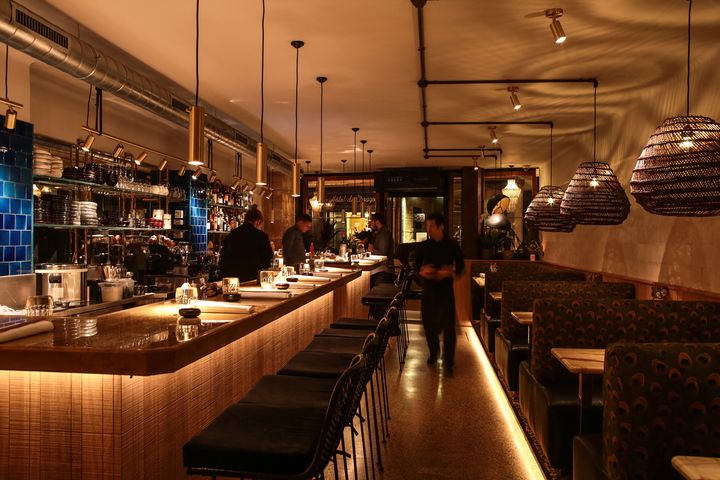
The Terrace Brasserie at Fouquet’s Paris
Oscar Wilde observed, “When good Americans die, they go to Paris.” Which is sufficient reason for me to try to be one, for, if I must spend an eternity somewhere, I doubt I’d ever run out of things to see, hear, do or taste in Paris. Indeed, it always strikes me that bad Americans who go to Paris and restrict their diet are like people who go to the movies and don’t buy popcorn. It’s really absurd.
Meanwhile, I try to pack as much time on earth into visits to Paris and to dine from the top, where the cuisine can be sublime, to the bottom, where the food is usually wonderful.
FOUQUET’S Paris
Hôtel Barrière Le Fouquet’s Paris
46 Avenue George V
+33 1-4069-6000

For lunch, I chose a favorite venue from which my wife and I could watch the flow of Parisians and visitors walk slowly up and down the Champs Élysées, which always includes a line of Japanese women exiting the Louis Vuitton flagship store across the street.
Fouquet’s Paris began in 1899, named after its owner, Louis Fouquet, who sought to attract well-to-do American tourists and knew the value of advertising “American Drinks & Cocktails.” The restaurant survived two World Wars, the Depression, changing fashions, persnickety landlords and, in the 1970s, a fading of the Champs Élysée’s chic. A new owner, Maurice Casanova, in 1976 added the identifying red and gold awnings, which now seem as much a part of the revived boulevard as any landmark in Paris. Now, since 2006 attached to the Hôtel Barrière, everything at Fouquet’s has undergone a total restoration, and Chef Pierre Gagnaire has been brought on to oversee the contemporary menus.
An overcast day—pretty much a given in Paris in late October—did nothing to dampen our spirits at our table, though two cigar smokers did.

For 40 years Fouquet’s Paris has been host to the after party of the César film awards, so the interior dining room’s walls are lined with photos of actors and actresses, while just outside the restaurant a bronze plaque (above) in the ground lists many of the winners of the award.
The menu remains classic, with some modern flourishes. We began with a light lentil salad with poached egg and saucission, and I could hardly help ordering the onion soup au gratin, but I was disappointed because the soup’s cheese was not properly melted and its onions were only lightly caramelized. Gagnaire’s input can be seen in novel dishes like sea scallops in coconut milk, and lobster ravioli in a foamy Nantua-like sauce. For dessert, the traditional profiterole (below) is not bettered by any in Paris.

Our chilled bottle of rosé reminded me that, as the song says, “I love Paris in the winter, when it drizzles.” And looking up the slight incline of the Champs Élysées towards the Arc de Triomphe, I almost imagined seeing Anouk Aimée in the middle of the street and hearing that lovely lilting music from the film A Man and a Woman.
LE BAR DES PRÉS
25 Rue du Dragon
+33 (0) 623 74 30 55

On arriving in Paris this fall, my wife and I were in the mood for something new, so we headed to Cyril Lignac’s delightful year-old Le Bar des Prés, which is right next door to his two-year old modern bistro, Aux Pres. I’ve long admired Lignac’s cuisine at his upscale Le Quinzieme, and this new place expands upon his interest in global flavors.
Le Bar des Pres is small, with a bustling bar and just a few tables along the wall. It gets a young crowd, yet, this being Paris, there is none of that ear-ringing cacophony you’d find at a comparable spot in New York City. It’s one of those places that from the street looks like the coolest place in the neighborhood, in this case on the Left Bank in the 7th Arrondissement.

The menu begins with two pages of specialty cocktails—unusual in Paris, and each only 5€ —then two more pages of regional wines, with several under 50€; then a two-page menu, skewered to Asia, especially Japan, so it begins with sashimi (an assortment is 24€; sushi, six pieces for 28€). These were certainly among the best examples of raw fish I’ve had in Paris—something I don’t usually seek out—with the same commitment to quality as in French dishes at Lignac’s other places.

“To Share” dishes went from a warm tomato in vinaigrette caramelized with miso, avocado and croutons (18€) to Brittany lobster salad with figs, walnuts and sansho pepper (28€). Well-fatted chu-ton tuna was semi-cooked, dashed with ponzu sauce and a warm toasted sesame oil (20€), while a crispy pancake contained crab in a light Madras curry sauce with avocado and lime (22€).
The flavors were tantalizing in each dish, the colors brilliant, and the devotion to complementary textures rife throughout. Everything was beautifully, simply presented, the pacing of the meal was flawless, and everyone was clearly having a very happy time of it.
Desserts follow the same line, by taking a traditional baba au rhum and giving it a dollop of Matcha green tea ice cream (12€); fresh, perfect raspberries cuddled in whipped cream and a coconut sorbet (11€), while Japanese tapioca came in coconut milk with pineapple confit scented with vanilla (11€). For something nostalgic there is a plate of rich profiteroles with vanilla and tonka beans and caramelize hazelnuts (11€).
I don’t care a whit for what’s “hot” in any city, for it’s easy enough to tell that Le Bar des Prés is packed because people who know great sushi take every seat every night.
AU PETIT TONNEAU
20 Rue de Surcouf
+33 1-4705-0901

Every Parisian has a favorite neighborhood bistro, and in the area near Les Invalides, Au Petit Tonneau is mine. Typical in its simple décor—small, narrow, with red-checkered tablecloths, vases of flowers, old tiles, a little shelf of books, a blackboard menu, and a jolly staff—this 80-year-old wonder makes old-fashioned fare that never seems old-fashioned at all. You never have the feeling the kitchen, now under Chef Vincent Neveu, is just coasting or neglecting any aspect of its ingredients or preparation, from a sweet onion tart confit (below) on flakey pâte brisée with a generous shower of black truffles (20€) and a poêle of woodsy girolles mushrooms (20€) to a blanquette de veau (24€) so rich and aromatic that I was reminded of the first example I ever ate in Paris, fifty years ago.

Bass came with a lovely herbaceous sauce vièrge (24€) and a hint of curry. Desserts were very traditional—a tangy lemon tarte (below) and a not-too-sweet tarte Tatin of caramelized apples.
According to Paris food writer Alexander Lobrano, “Obliged to sell by poor health, Au Petit Tonneau’s chef owner Ginette Boyer was determined to sell to a woman, because she hoped to preserve the legacy of the cuisine menagère (home cooking) that had won her a devoted following of local regulars through the years. In the end, Arlette Iga, a client of the restaurant, decided to buy, and she’s respecting Boyer’s wishes by serving the type of uber traditional French comfort food that’s become nearly extinct in Paris.”

There is a polished brass plaque on the wall (just above the banquette in the photo above) that tells you Jules Maigret, the gourmand detective in many of the Georges Simenon novels, dined here often, if fictitiously, just as Sam Spade did at John’s Grill in San Francisco in The Maltese Falcon.
By the way, there is at least one other restaurant in Paris with the word “tonneau” (barrel) in it, but the one on the Rue de Surcouf is the only one that matters.
There is a 37€ fixed price dinner offered in addition to à la carte.
CAMÉLIA
Mandarin Oriental Paris
251 Rue Saint Honoré
+33 (0) 1-7098-7400

The Mandarin Oriental Paris near Place Vendôme takes a very modern tack in its décor, which gives its dining room, Camélia, a look that might resemble the commissary on the Starship Enterprise—white chairs on white tile floors and white floors, white amoeba-shaped ceiling panels, huge white flower petal shapes behind the banquettes, white flowers and recessed ceiling lights.
There is a Japanese element to Chef Thierry Marx’s composed dishes on rustic ceramics. Portions are not lavish and prices high, as with “La Saint-Jacques,” meaning one large seared scallop with artichokes (62€). Leeks cooked in foil so as to steam came cold atop romaine lettuce with a truffled vinaigrette (32€), and an onion Roscoff was set into a modernist foam sauce with a duxelle of mushrooms (29€). More substantial was suckling pig with sesame, maki wasabi mayonnaise (46€), and a dish of succulent chicken with coffee-infused parsnip and honeyed gravy (56€). The best of the desserts tried was a gâteau St. Honoré. There is an extensive list of wines by the glass, starting at 13€; otherwise bottle prices are expensive.
Camélia is the more casual restaurant at the hotel, with Sur Mesure par Thierry Marx the gourmet room. In warm weather, the garden is where you want to sit, sip some Champagne and wile away the afternoon. There is a 78€ "Shopping Lunch," a tea time menu and Sunday brunch is 108€.
